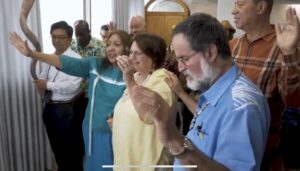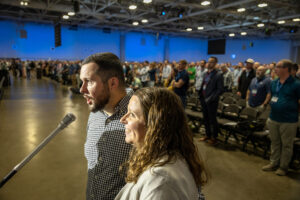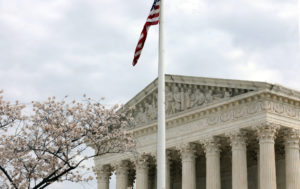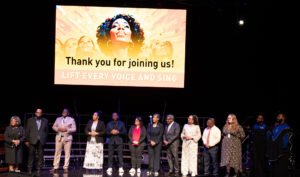
LOUISVILLE, Ky. (BP)–The so-called James Ossuary needs a careful, in-depth examination by a scientific team to determine, once and for all, whether it is an authentic relic in which the brother of Jesus was buried or merely a common first-century burial box with a phony inscription, a Southern Baptist seminary professor says.
The ossuary that made a worldwide splash in 2002 was back in the news Dec. 29 when police in Jerusalem filed criminal indictments against four antiquities collectors, accusing them of forging biblical artifacts, many so skillfully that they fooled experts. One of the artifacts was the James Ossuary.
But not all experts believe the James Ossuary is fake — renowned paleographer Andre Lemaire contends that the Aramaic inscription was penned in the first century.
Steven Ortiz, assistant professor of archaeology at New Orleans Baptist Theological Seminary, says that fake items are common among antiques dealers but the James Ossuary needs further scientific analysis before a final verdict is pronounced.
“You have antiquities dealers who sell actual objects and forged objects,” he said. “You have two or three archaeologists who have looked at it and said it is authentic and two who have said it is not. You have a geologist from the Royal Ontario Museum [in Toronto, Canada] who says it is authentic. So what you need to do is to get scientists in a room, and, like any project, you need a scientific report.
“What is sad about the James Ossuary is the way it hit the news was sensational. With all the hoopla there was not a sober analysis of the ossuary itself. What we have now is people on both sides who have a lot of emotion and careers at stake.”
The ossuary — a stone box that holds the bones of the dead and used by Jews from around 20 B.C. until 70 A.D. — first made worldwide news in 2002 and was authenticated by Lemaire and others.
The ossuary contains an Aramaic inscription on the side reading, “James, son of Joseph, brother of Jesus” — leading scholars to speculate it once contained the remains of the Apostle James. It was valued at $1 to $2 million.
Among those recently indicted was dealer Oded Golan. He was arrested in July of 2003 after police found forging equipment — stencils, stones and yet-to-be-completed forgeries — in his home, according to The Jerusalem Post.
Golan is suspected of forging both the James Ossuary and another archeological find, a stone tablet with an inscription from 2 Kings 12 calling for temple repairs. Both finds are now in doubt, although Golan contends they are authentic.
Even before Golan’s arrest, the Israel Antiquities Authority said in June of 2003 that both items were fake. Scholars reached their conclusion about the James Ossuary by studying the weathering process. They determined that the patina, a thin film that covers the stone and is acquired with age, had been broken, AP reported.
Ortiz pointed out that the Dead Sea Scrolls were at first believed to be counterfeit, but after years of examination and analysis by scholars, they were authenticated.
“Every major find, including the Dead Sea Scrolls, were considered forgeries at first,” Ortiz said. “Eventually, it has the weight of analysis by scholars and eventually [the consensus] will lean toward one way or the other like the Dead Sea Scrolls. This is very common.
“For every major inscription, you have two major epigraphers who claim it is a forgery. And that is why we need more archaeologists and more archaeological research collecting things in the proper scientific method.”
In the July/August issue of Biblical Archaeology Review — the publication where the ossuary was first showcased — scholar Edward J. Keall says that new tests bolster the case for its authenticity. Keall serves as a senior curator at the Toronto Royal Ontario Museum, where the ossuary was displayed in 2003.
“The studies we conducted have convinced us that the ossuary and its inscription are genuinely ancient and not a modern forgery,” he writes.
Keall argued that there is evidence to support that the James Ossuary is authentic. Biblical scholars and scientists spent several months studying the ossuary; testing by the Geological Survey of Israel confirmed that the limestone is from the Jerusalem area, quarried in the first and second century B.C., Keall asserted.
Microscopic analysis matched the surface patina to the patina in the grooves of the inscription, Keall asserts, saying it indicates that the ossuary and the inscription are the same age. The patina did not contain any modern elements and is consistent with cave burial and there were no signs of modern tool marks, he says.
The study of ancient writing (epigraphy) also helps to establish the date of the James Ossuary, Keall says. The words used in the inscription for “son” and “brother” attest to its being Aramaic, the everyday language of Jesus and the Apostles. The general style of the letters places the inscription in the 20 B.C. — 70 A.D. time range, he says.
The ossuary’s archaeological origins represent a crucial unknown factor. The owner says he purchased the ossuary from an antiques dealer, who is thought to have obtained the object from an Arab laborer, who found it in a cave near Silwan, just outside Jerusalem, according to Israeli news reports.
The ossuary did not come from a scientifically controlled excavation, where every detail would be plotted and the association with any other objects recovered would be noted.
Whether the James Ossuary is ever authenticated or not is a matter of significance for the field of archaeology but is not pivotal in bolstering of the historicity of Christianity, Ortiz said.
“What’s at stake is the integrity of the discipline of archaeology,” Ortiz said. “Whether the James Ossuary is [authentic], we can’t say it was the actual James the brother of Jesus.
“James was a common name and so was Jesus in the first century. Statistically, it does lean toward that but it has never changed anybody’s stance on the historicity of the events recorded in the Gospels. So it is pretty much a non-issue in terms of faith. I don’t know anybody whose faith because of the James Ossuary was deemed authentic and I don’t know anybody’s faith that is going to be weakened because it is proven a forgery.”
–30–













